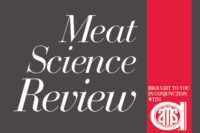It is a grand time to merchandise grinds.
Such factors as the versatility of ground meats in a wide range of recipes, the increasing popularity of ethnic meals that leverage ground meats and the typically lower prices of grinds compared with other protein cuts is bolstering consumer interest in the proteins.
Ground beef is by far the largest contributor to retail beef dollar sales, generating $8.4 billion in 2013, compared with $4.4 billion for loins, the next largest sales category, according to the Power of Meat 2014 report, published by the Washington, D.C.-based American Meat Institute (which merged this year with the North American Meat Institute) and the Arlington, Va.-based Food Marketing Institute.
The report also found that consumers were making 12 percent more international or ethnic dishes compared with five years earlier.
That strong activity is helping to trigger the launch of advanced grinding technologies. Newer designs are intended to enable processors to have more efficient and effective grinding operations that produce higher quality and more visually appealing products, while enhancing food safety.
“The grinding industry is being redefined,” says Brent Cator, president and owner of Cardinal Meat Specialists Ltd., a Mississauga, Ont.-based processor. “There are huge advancements in the technologies that are allowing people to get minimally processed products with the best flavor attributes and which provide the best eating experience.”
Among the newer elements, says Brett Chambers, operations lead, ground beef and finely textured beef, for Wichita, Kan.-based Cargill Inc., are improvements to X-ray and vision technologies to reduce foreign materials in grinds, and technologies that more accurately determine lean content.
“There is a reduction in quality concerns from foreign material and/or bone,” he says, adding that enhancements also are resulting in better quality experiences during cooking, including improved flavor or texture.
In addition, newer designs enable processors to reduce or eliminate pressure on grinds during high-speed processing, which helps diminish meat mushiness, Cator says. Producers are enhancing grind quality through functions that enable more efficient removal of dense bone chips, connective tissues and gristle, he notes.
Search far and wide
Processors can pinpoint the most advantageous technologies and grinding techniques by evaluating the equipment being developed by both domestic and international vendors, and the efforts of other processors.
“Very few operators take the time to learn what is going on in foreign markets and then finding a way to ‘North Americanize’ it,” Cator says. He notes European companies are devising many of the newer grinding technologies, some of which are improving food safety by giving users easier access to crevices and other hard-to-clean areas, and enabling heat to transfer evenly through grinds during cooking.
Processors can improve their grinding operations by combining progressive technologies with strong operating procedures, such as ensuring meats remain at optimal temperatures and performing ongoing equipment maintenance, including blade sharpening.
“Processors’ capabilities dramatically increase when they combine best practices with newer technologies,” Cator says. “Those who have not invested in the equipment and processes will become redundant fast.”
Major maintenance focus
Operating procedures also should include the precise alignment of all machine components for maximum efficiency, says Joseph Cordray, extension meat specialist in the Department of Animal Science at Iowa State University in Ames. (Editor’s Note: See Dr. Cordray’s article on sausages on page 63 in this issue.)
“The biggest grinding mistake processors make is not having their equipment set up correctly,” he says. “It’s an ongoing issue along with equipment maintenance.”
Dull knives and plates, and well as inappropriate knife and plate combinations, can result in poor meat texture and a dull appearance, says Robert Delmore, a professor in the department of animal sciences at Colorado State University in Fort Collins.
“Having blades and knives remain sharp is 100 percent critical,” he says. “Large and small processors must work with their equipment suppliers to guarantee that they are sharpening the equipment properly, resurfacing plates and determining the plate sizes that work best for specific products.”
Technology enhancements also are intended to prevent the overworking of meat. Designs that apply less force during grinding helps to retain natural textures and flavors, says Mark Gwin, research and development manager for value-added products at Certified Angus Beef LLC, in Wooster, Ohio.
He notes that avoiding overworking, while ensuring meats are kept at the best processing temperatures, are major grinding challenges.
“It is essential that there is constant vigilance,” Gwin says. “The product must be kept as cold as possible, which newer technologies help to ensure.”
Delmore agrees, noting processors should grind meats at temperatures of between 28 and 32 degrees Fahrenheit.
Warmer proteins, particularly those with temperatures of 40 degrees Fahrenheit or greater, create added friction during processing. The subsequent overworking can lead to sausage with a rubbery texture; grinds with a smeared, rather than a bright and clear, appearance; and a shorter product shelf life, he says.
Mushy grinds, instead of particles with a distinct and meatier appearance, also result from improperly installed grinder plates or worn plates and knives, Cordray says, adding that the additional friction can lead to a 10-degree rise in temperatures during grinding.
Next stage: safety
While newer technologies are helping to improve the quality and appearance of grinds, future equipment will also likely address emerging food safety issues, analysts say.
“The importance of food safety won’t go away,” says Christy Bratcher, associate professor of animal science at Auburn University, in Auburn, Ala. “Regulation and testing is always a hurdle grinding facilities will have to jump through.”
In addition to testing for E. coli O17:H7, she says technologies also will increasingly focus on Salmonellacontrol.
“Emerging pathogens will keep changing,” Bratcher says. “There is a need to keep focusing on interventions to be sure we kill all bacteria.”
Managing Salmonellawill become an increasingly greater challenge because the pathogen can situate in the lymphatic system of cattle, making it difficult to access, says Keith Belk, a professor in the Center for Meat Safety and Quality in the Department of Animal Sciences at Colorado State University.
“Calf producers will need to figure out how to prevent Salmonellafrom harboring in the lymph area,” Belk says. “Once it gets to the grind portion, there is not much you can do about it.”
In addition to a food-safety focus, future designs also will address lean points, texture and quality verifications, Cargill’s Chambers notes.
With grinds front and center in the meat-merchandising sector, the motivation for technology developers to create cutting-edge designs remains robust.





Report Abusive Comment